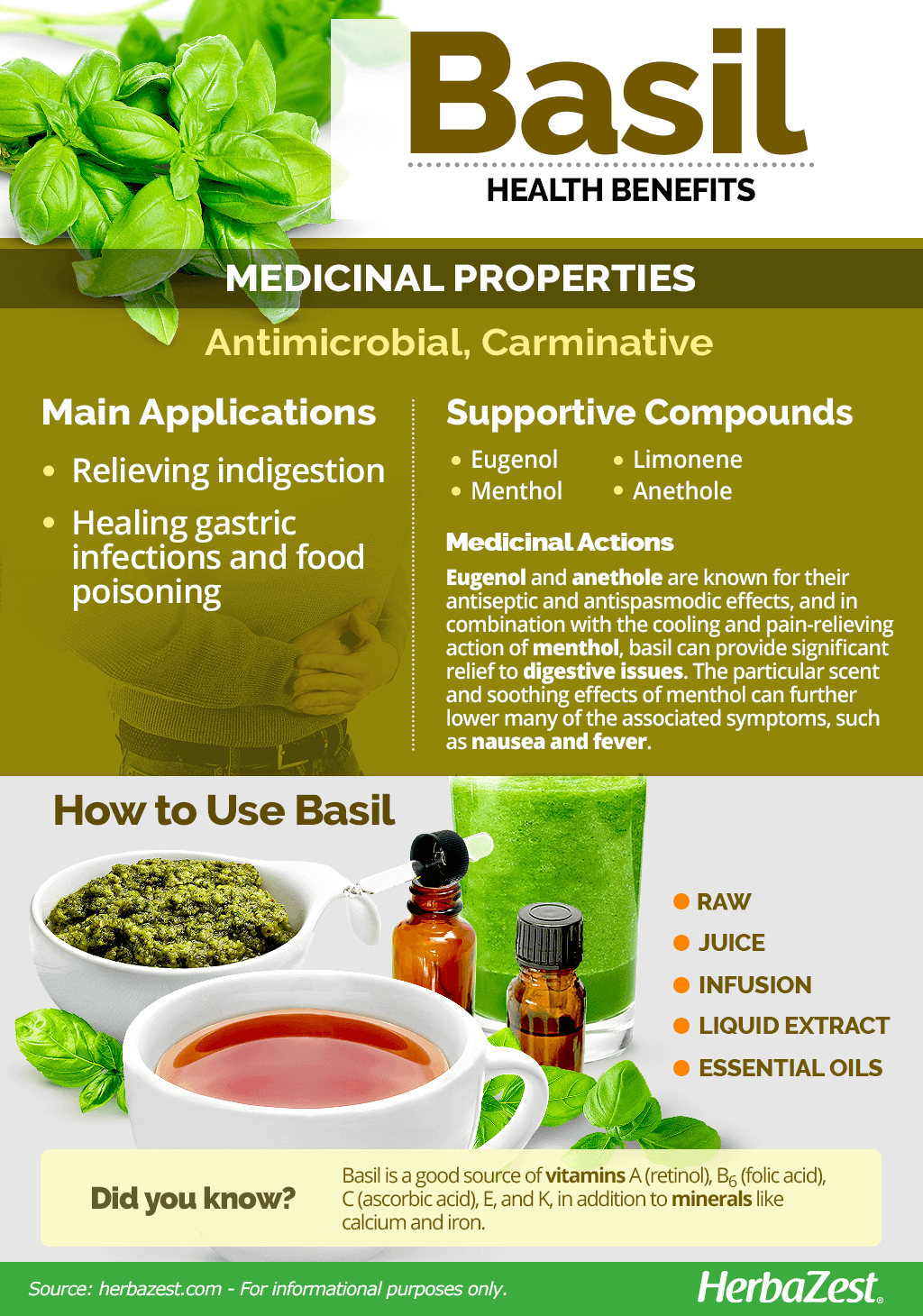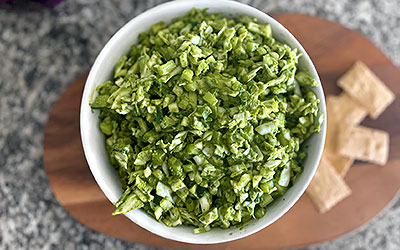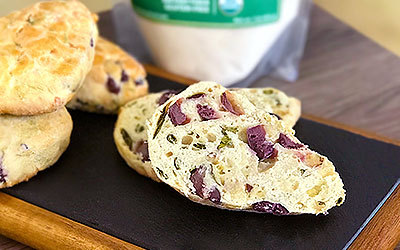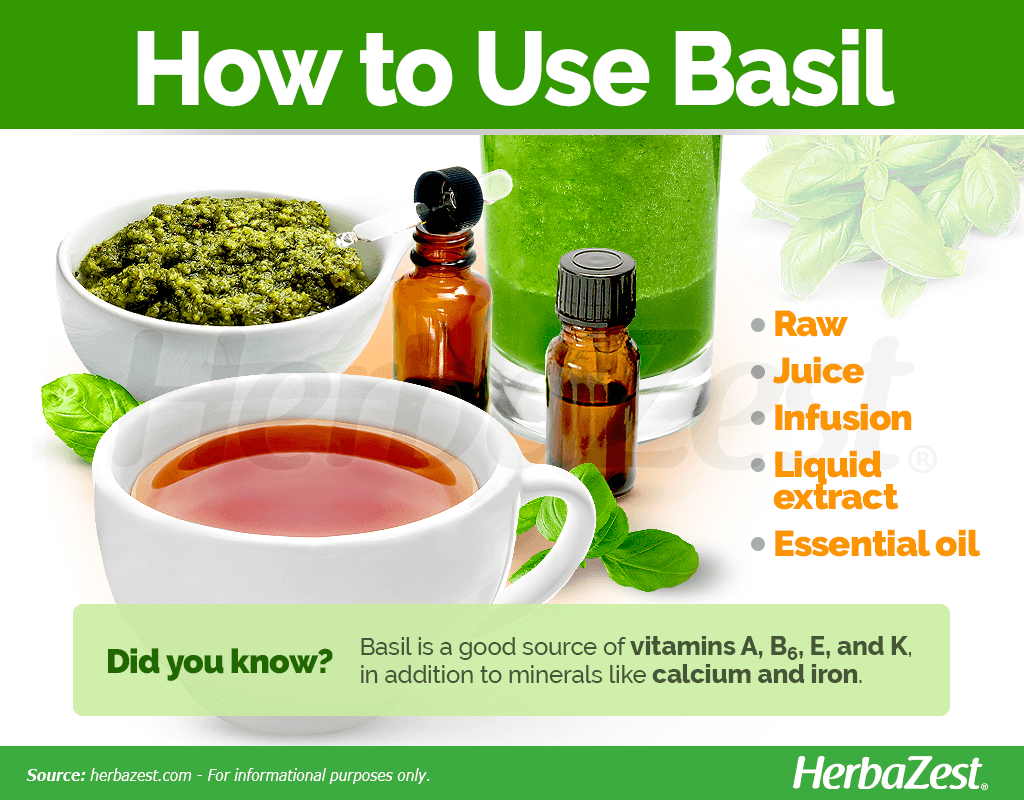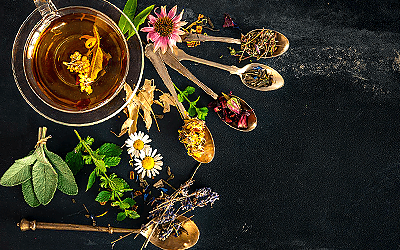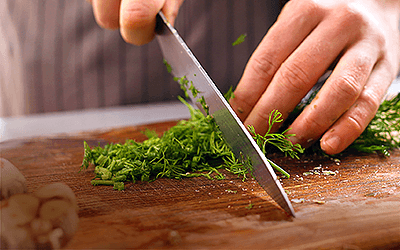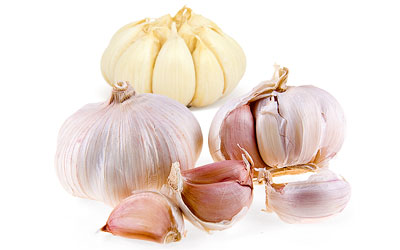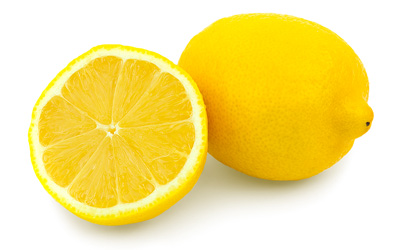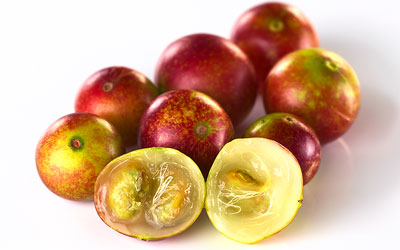Basil has been one of the most popular plants used by humans for centuries. Archeologists believe basil was first cultivated as a food crop approximately 5,000 years ago, possibly near or in Western India. Throughout the centuries, basil's soothing aroma, distinguished flavor, and medicinal prowess turned it into one of the most beloved culinary herbs. Nowadays, it remains a staple ingredient in many ethnic cuisines.
Basil Medicinal Properties
- Medicinal action Antimicrobial, Carminative
- Key constituents Eugenol, menthol, limonene, anethole
- Ways to use Hot infusions/tisanes, Liquid extracts, Juiced, Tincture
- Medicinal rating (3) Reasonably useful plant
- Safety ranking Safe
Health Benefits of Basil
Basil is not only useful for many culinary dishes, but also for numerous medicinal purposes. Main traditional uses of basil include:
Relieving indigestion. The carminative properties of basil make it ideal for relieving flatulence and stomach discomfort.
Healing gastric infections and food poisoning. Basil has numerous antimicrobial properties, which help relieve digestive issues, such as gastroenteritis.
In addition to its main health benefits, other medicinal actions of basil include:
Stopping hiccups. Although not corroborated by science, it is believed that basil essential oil can halt the involuntary, spasmodic contractions of the diaphragm that close the throat and produce hiccups.
Reducing blood sugar levels. Because of its hypoglycemic properties, basil can lower blood sugar levels.
Preventing blood clots. With its anticoagulant properties, basil can help prevent the formation of blood clots.
How It Works
The vast variety of basil medicinal uses lies in its essential oil, which is made up of a combination of approximately 80 different compounds, the most notable ones being eugenol, menthol, limonene, and anethole, which provide anti-inflammatory, cooling, antiseptic, and antibiotic actions to basil remedies.1,2
Although basil's exact mechanism of action is yet to be fully understood due the high number of compounds involved, eugenol and anethole are known for their antiseptic and antispasmodic effects. In combination with the cooling and pain-relieving action of menthol, basil can provide significant relief to digestive and metabolic issues.3,4 The particular scent and soothing effects of menthol can further lower many of the associated symptoms, such as nausea and fever.
The nutritional value of basil is remarkable as well: it is touted as a source of vitamins A, B6, C, E, and K, in addition to minerals, like calcium and iron.
Antimicrobial properties are also present in meadowsweet and thyme, whereas dill and fennel provide similar carminative benefits.
Basil Side Effects
Consuming basil is likely safe in most instances, especially in its culinary form. However, basil does contain estragole, a chemical compound which can lead to liver damage when consumed in excess.
Cautions
Due to its hypoglycemic properties, those who suffer from diabetes should exercise caution when consuming basil because it can lower blood sugar levels.
Basil also acts as an anticoagulant, so consuming it before surgery or when taking certain blood pressure medications is not recommended.
Children as well as women who are pregnant or breastfeeding should also limit their basil intake because it contains estragole.
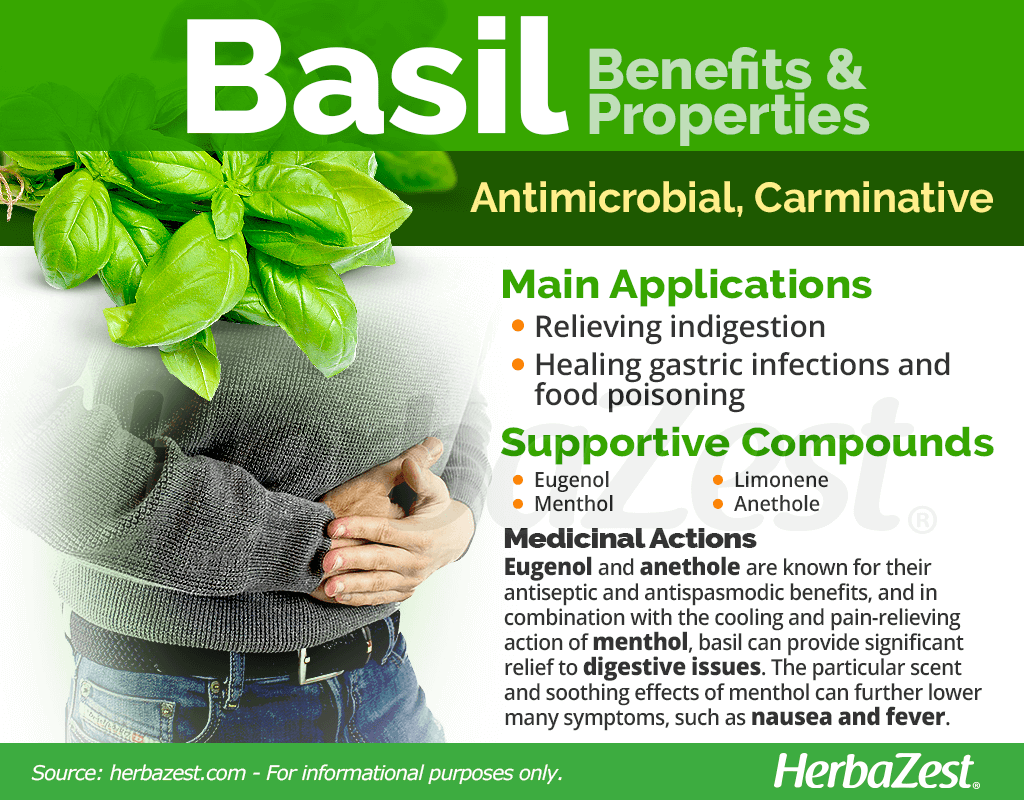
Basil Nutrition
Basil is not only an aromatic herb but also provides important nutrients in surprisingly high amounts; such is the case of vitamin K (phylloquinone), which helps coagulation, preventing hemorrages and speeding up wound healing. Basil fresh leaves also provide generous amounts of provitamin A carotenoids, crucial for collagen production that facilitates skin regeneration; vitamin C (ascorbic acid), necessary for proper iron absoption and immunity; and folate, a key vitamin that allows cell replication and is particularly important both for women who want to conceive and during pregnancy.
On the mineral departament, basil is also full of surprises. Fresh basil leaves provide impressive amounts of manganese, copper, and iron. While manganese contributes to a healthy bone structure, copper and iron are crucial for red blood cells formation and transport. Additionally, good levels of calcium and potassium make of basil leaves a great choice for strong bones as well as proper muscle and nervous function.
The nutritional profile of basil is rounded by the presence os a variety of other nutrients in small amounts, such as B vitamins, vitamin E, choline, zinc, magnesium, phosphorus, and selenium.
100 grams of basil fresh leaves provide 6%DV of protein, 1%DV of carbohydrates, 1.6%DV of fiber, and 23 calories.
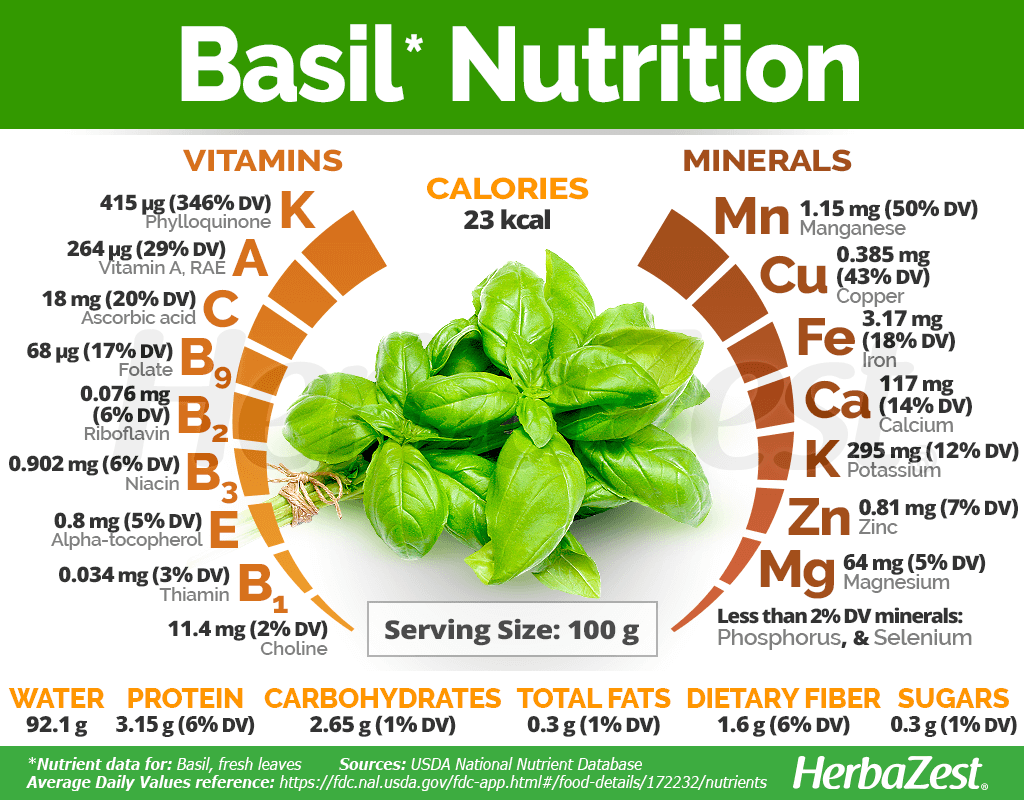
How to Consume Basil
- Edible parts Leaves
- Edible uses Condiment
- Taste Aromatic, Earthy
Natural Forms
Raw. Whether fresh or dried, basil leaves are typically consumed in salads or as a flavor enhancer or garnish in many other dishes, such as pizza or pesto sauce. When consumed in this form, basil can relieve indigestion and flatulence.
Infusion. A hot basil tea offers numerous medicinal effects. It can alleviate flatulence, heal gastric infections, and prevent blood clots.
- Juice. In this form, basil can aid digestion and lower blood sugar levels.
Herbal Remedies & Supplements
Unlike its Indian relative, holy basil, sweet basil is rarely used in remedial or supplemental forms. Basil extract is employed as a flavoring agent in culinary preparations, and basil essential oil is popular in aromatherapy due to its refreshing and energizing aroma.
Growing
- Life cycle Annual
- Harvested parts Flowers, Leaves
- Light requirements Full sun
- Soil Loamy sand
- Soil pH 6.1 – 6.5 (Slightly acidic)
- Growing habitat Temperate climates, Subtropical regions
- USDA Plant Hardiness Zones 4a, 4b, 5a, 5b, 6a, 6b, 7a, 7b, 8a, 8b, 9a, 9b, 10a, 10b
- Plant spacing average 0.25 m (0.82 ft)
- Propagation techniques Cuttings
- Potential insect pests Beetles
Native to tropical regions, basil grows best in sunny, warm climates with approximately 6-8 hours of sunlight per day. Under such ideal conditions, some cultivars of basil can behave as perennials, although any exposure to frost or harsh temperatures will cause it to behave as an annual.
Growing Guidelines
The ideal temperature for germination is 68°F (20°C), while growing temperatures can range from 45 - 8°F (7 - 27°C).
Basil is susceptible to frost and cold temperatures, so it is important that it is exposed to full sunlight in order to thrive.
It is important to water basil regularly, since it does not tolerate drought-like conditions very well.
Basil requires well-drained, fertile soils in order to grow.
Because basil has deep roots and is vulnerable to invasive weeds, mulching the soil surrounding is recommended.
Basil seeds should be sown six to twelve inches (15 - 30 cm) apart.
Basil is vulnerable to slugs, beetles, leafminers, caterpillas, and grasshoppers, so minor pest control is recommended in order to keep this herb healthy.
Basil is vulnerable to certain species of fungi, including Rhizoctonia solani, Pythium spp. and Phytophthora spp.
Detailed information about growing basil can be found in the herb garden section.
Additional Information
- Other uses Repellent
Plant Biology
Sweet basil has square stems, two-lipped flowers, and abundant fragrance oil-bearing glands that are typical of the Lamiaecae family.
Classification
Basil is a member of the Lamiaecae or mint family, which is characterized by fragrant leaves and contains over 7,200 species, most notably peppermint (Mentha x piperita), rosemary (Rosmarinus officinalis), sage (Salvia officinalis), oregano (Origanum vulgare), thyme (Thymus vulgaris), and lavender (Lavandula officinalis).
Sweet basil's botanical name, Ocicum basilicum, derives from the Greek okimon (smell) and basilikon (royal).
Relatives and Varieties of Basil
Sweet basil (Ocimum basilicum) has two close relatives: holy basil (Ocimum tenuiflorum) and lemon basil (Ocimum xcitriodorum). However, sweet basil is the most common type of basil cultivated.
Two popular varieties of sweet basil are Thai basil (O. basilicum var. thyrsiflora), which is used in Asian cooking, and lemon basil (Ocimum var. citriodorum), white-flowered and smaller-leaved, with a pronounced citrus fragrance.
Historical Information
Originally native to southerneast Asia and the South Pacific islands, basil is believed to have been first domesticated over 5,000 years ago in West India, where it was considered a sacred plant. Traces of its history can be found in numerous texts across Europe dating as far back as Ancient Greece during the reign of Alexander the Great. Basil made its way to England in the 16th century and to the Americas in the 17th century.
Economic Data
Basil is an important economic crop, used widely for both its culinary and medicinal uses. The United States, France, and the Mediterranean region are currently the largest producers of basil. This herb produces 100 tons of essential oil worldwide every year, and the basil industry is worth around $15 million annually.
Popular Beliefs
In its native India, the leaves were used in courtrooms for the accused to swear their oath on. In Italy, Mexico, and Romania, basil branches were given from men to women as a symbol of their love.
One of the most infamous superstitions of the 16th century was considering basil as a poisonous herb, due to its inability to grow in the presence of rue. Some physicians even believed that by simply smelling basil, scorpions would grow in the brain.
Other Uses of Basil
Repellent. Basil's essential oil is very toxic to mosquitoes, acting as both a repellent and poison to their eggs.
Gardening. Since basil is a hearty, low maintenance herb, many amateur gardeners like to plant it in their herb gardens.
Sources
- Clinical Experiments in Pharmacological Physiology, Antiviral activities of extracts and selected pure constituents of Ocimum basilicum, 2005
- International Journal of Clinical Pharmacology and Therapeutics, Randomized placebo-controlled, single blind trial of holy basil in patients with noninsulin-dependant diabetes mellitus, 1996
- Parasitology Research, Antigiardial activity of Ocimum basilicum essential oil, 2007
- Veterinary Parasitology, Anthelmintic activity of essential oil of Ocimum gratissimum Linn. and eugenol against Haemonchus contortus, 2002
- Germplasm Resources Information, Taxon: Ocimum basilicum L.
- Journal of Agricultural and Food Chemistry, Characterization of the volatile composition of essential oils of some lamiaceae spices and the antimicrobial and antioxidant activities of the entire oils, 2006
Footnotes:
- Phamaceutical Biology. (2010). Antibacterial properties of essential oils and methanol extracts of sweet basil Ocimum basilicum occurring in Bangladesh. Retrieved March 1, 2022 from: https://pubmed.ncbi.nlm.nih.gov/20645791/
- Journal of Pharmaceutical Sciences. (2017). Pharmacological and Toxicological Properties of Eugenol. Retrieved March 1, 2022 from: https://www.ncbi.nlm.nih.gov/pmc/articles/PMC7227856/
- Iranian Journal of Pharmacology. (2018). The Effects of Ocimum basilicum Extract and Its Constituent, Rosmarinic Acid on Total and Differential Blood WBC, Serum Levels of NO, MDA, Thiol, SOD, and CAT in Ovalbumin Sensitized Rats. Retrieved March 1, 2022 from: https://www.ncbi.nlm.nih.gov/pmc/articles/PMC6269586/
- Journal of Intercultural Ethnopharmacology. (2016). Inhibitory effect of leaves extracts of Ocimum basilicum and Ocimum gratissimum on two key enzymes involved in obesity and hypertension in vitro. Retrieved March 1, 2022 from: https://www.ncbi.nlm.nih.gov/pmc/articles/PMC5061483/
